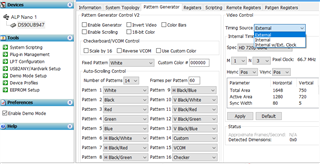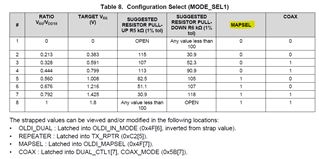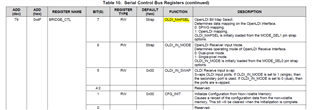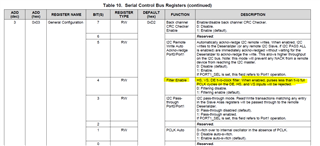Tool/software:
Hello Team,
The setup is quite simple, UB947 > UB948. Could you please give some advice how to solve this problem?
I could generate internal pattern via the following configurations attached. I know the UB948 is locked to UB947 by checking DSUB948_ReadBytes(0x28) and DSUB948_ReadBytes(0x1C)
Thanks
Kexiang
the setup could generate internal pattern via the following configurations:
// initialize the page 10 after power up
DSUB947_WriteBytes(0x40,0x10); // select OLDI register
DSUB947_WriteBytes(0x41,0x49); // force PLL controller in PPM reset state
DSUB947_WriteBytes(0x42,0x16);
DSUB947_WriteBytes(0x41,0x47); // force PLL LOCK Low
DSUB947_WriteBytes(0x42,0x20);
DSUB947_WriteBytes(0x42,0xA0); // reset PLL divider
DSUB947_WriteBytes(0x42,0x20);
DSUB947_WriteBytes(0x42,0x00); // release PLL LOCK control
DSUB947_WriteBytes(0x41,0x49);
DSUB947_WriteBytes(0x42,0x00); // release PLL state control
// 2C Control
DSUB947_WriteBytes( 0x03, 0xDA);
DSUB947_WriteBytes( 0x17, 0x9E);
// BRIDGE_CTL
DSUB947_WriteBytes(0x4F, 0xC0); // Single-pixel mode, OpenLDI mapping
// Gate RGB data with DE
DSUB947_WriteBytes(0x04,0x90); //Prevent AVMUTE for non-HDCP systems
//DUAL_CTL1
DSUB947_WriteBytes(0x5B,0x03); //Force dual FPD-Link, enable reset on PLL frequency change
//BCC Watchdog Control
DSUB947_WriteBytes(0x16,0x02); //Adjust BCC watchdog timer to minimum
//GPIO Pass through
DSUB947_WriteBytes(0x0E,0x35);
DSUB947_WriteBytes(0x0F,0x03);
DSUB948_WriteBytes(0x1E,0x53);
DSUB948_WriteBytes(0x1F,0x05);
// Initialize UB948
DSUB948_WriteBytes(0x4A,0x01); //Disable OLDI outputs on 948 to prevent screen glitches from appearing during the init process
DSUB948_WriteBytes(0x01,0x01); // snapshot reset
//Sleep 100ms
//Initialize SPI Mode
DSUB947_WriteBytes(0x43,0x06);
DSUB948_WriteBytes(0x43,0x06);
DSUB948_WriteBytes(0x4A,0x00); // Enable OLDI outputs on UB948
DSUB948_WriteBytes( 0x26, 0x16);
DSUB948_WriteBytes( 0x27, 0x16);
//PATGEN programming
DSUB947_WriteBytes(0x64, 0x10); //disabled patttern
DSUB947_WriteBytes(0x66, 0x04);
DSUB947_WriteBytes(0x67, 0x91);
DSUB947_WriteBytes(0x66, 0x05);
DSUB947_WriteBytes(0x67, 0x05); // h Total = 1425
DSUB947_WriteBytes(0x66, 0x06);
DSUB947_WriteBytes(0x67, 0x31); // v Total = 784
DSUB947_WriteBytes(0x66, 0x07);
DSUB947_WriteBytes(0x67, 0x00);
DSUB947_WriteBytes(0x66, 0x08);
DSUB947_WriteBytes(0x67, 0x05); //h Active = 1280
DSUB947_WriteBytes(0x66, 0x09);
DSUB947_WriteBytes(0x67, 0x30); //v Active = 768
DSUB947_WriteBytes(0x66, 0x0a);
DSUB947_WriteBytes(0x67, 0x28); // h sw = 40
DSUB947_WriteBytes(0x66, 0x0b);
DSUB947_WriteBytes(0x67, 0x02); //v sw = 2
DSUB947_WriteBytes(0x66, 0x0c);
DSUB947_WriteBytes(0x67, 0x32); //h bp = 50
DSUB947_WriteBytes(0x66, 0x0d);
DSUB947_WriteBytes(0x67, 0x06); //v bp = 6
DSUB947_WriteBytes(0x66, 0x1a);
DSUB947_WriteBytes(0x67, 0x09); //M=9
DSUB947_WriteBytes(0x66, 0x03);
DSUB947_WriteBytes(0x67, 0x61); //N=97 > 74.22
DSUB947_WriteBytes(0x65, 0x04); //internal clock and timing
DSUB947_WriteBytes(0x64, 0x05); // enable colorbar
// Force dual-link mode
DSUB948_WriteBytes(0x34,0x0A); // PORT1_SEL
DSUB948_WriteBytes(0x28,0x10);
// Forward SPI channel after RX is locked to TX by checking DSUB948_ReadBytes(I2C_ADDR_DSUB948, 0x1c)
DSUB947_WriteBytes(0x1E, 0x02);
DSUB947_WriteBytes(0x0F, 0x03);
DSUB947_WriteBytes(0x0E, 0x35);
DSUB947_WriteBytes(0x0D, 0x03);
DSUB948_WriteBytes(0x34,0x0A); // PORT1_SEL
DSUB948_WriteBytes(0x4B,0x02); // Adjust 0x4B
DSUB948_WriteBytes(0x1F,0x02); // GPIO3
DSUB948_WriteBytes(0x1E,0x02); // GPIO2-GPIO1 SPCLK MISO
DSUB948_WriteBytes(0x1D,0x02); // GPIO0 MOSI
DSUB948_WriteBytes( 0x43, 0x06); // Forward SPI channel
//////////////////////////////////////////////////////////////////////////////////////////////
DSUB948 is loss of lock once changed into external timing mode via the step:
DSUB947_Write(0x65, 0x0C);
//DSUB947_Write(0x65, 0x00); // default external timing enabled





